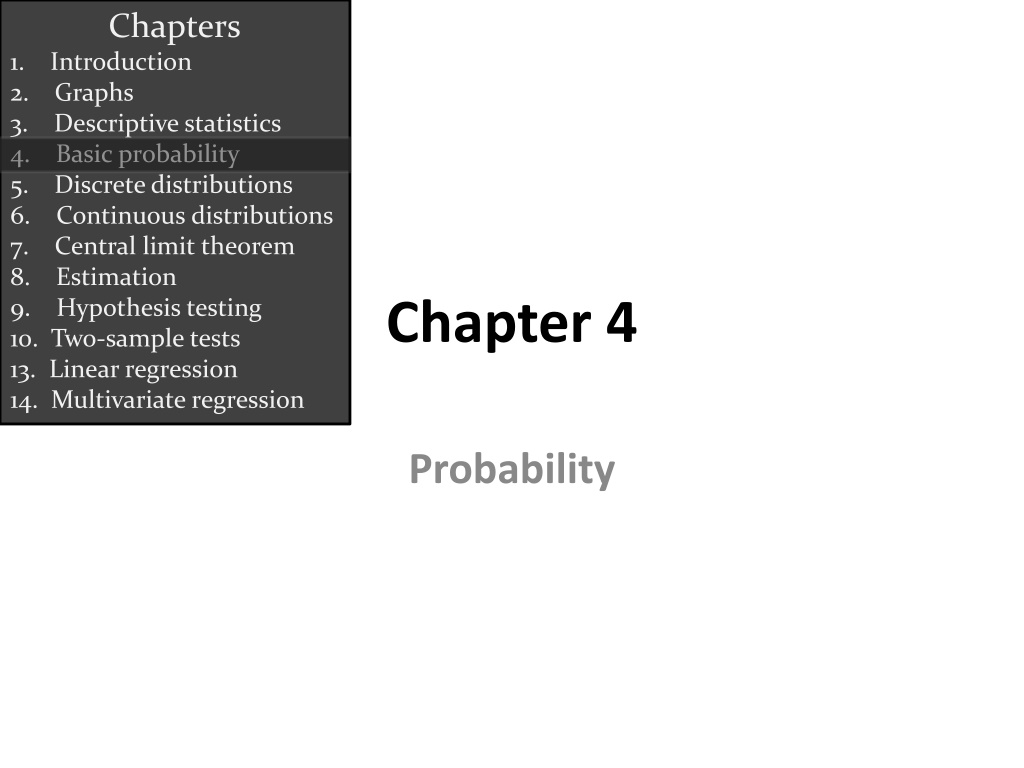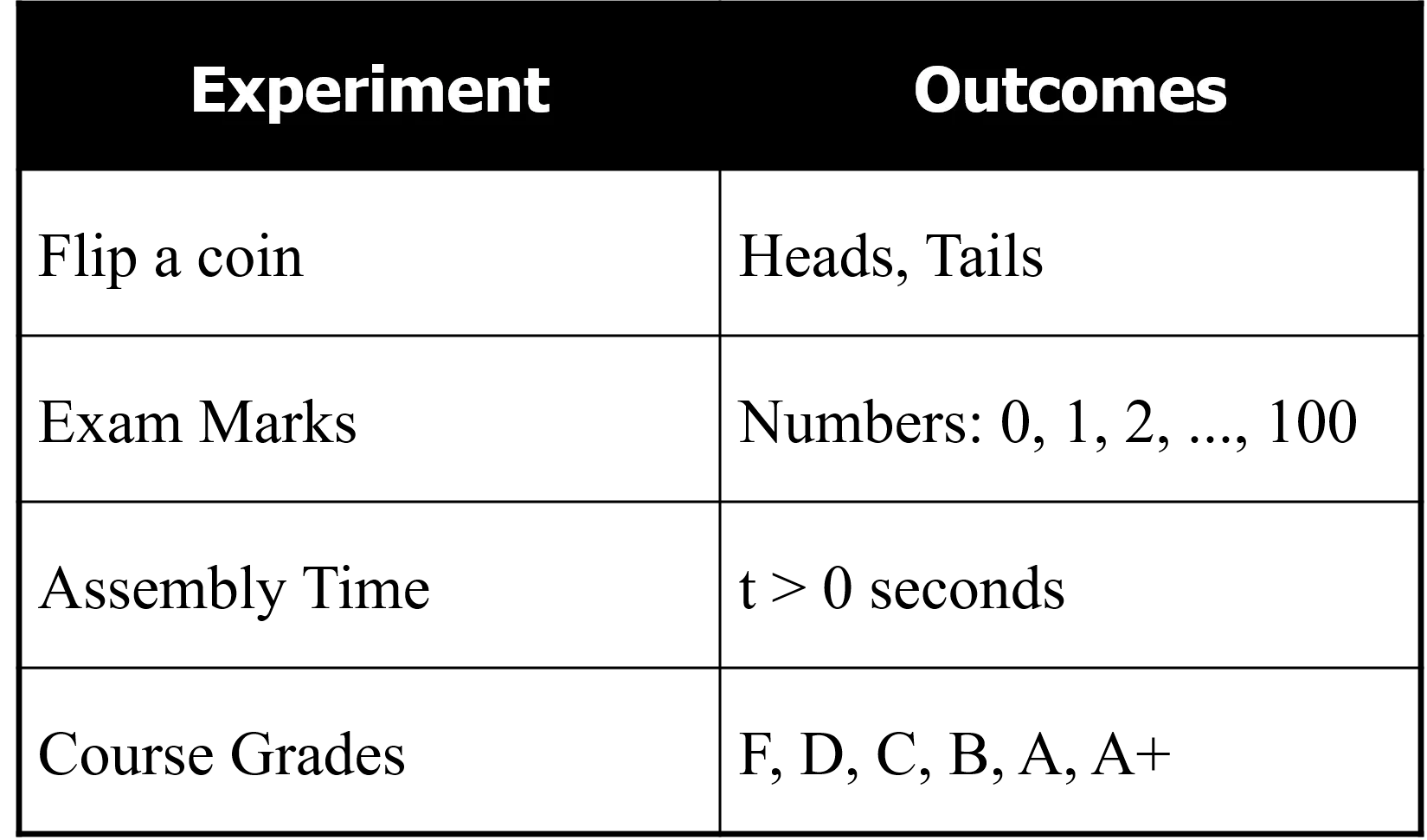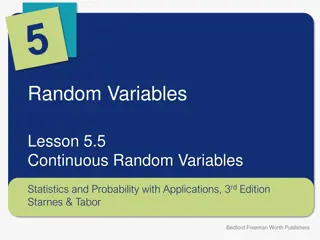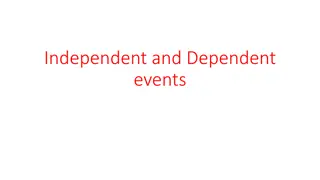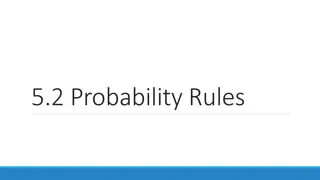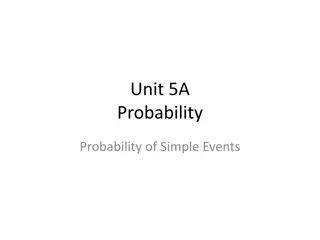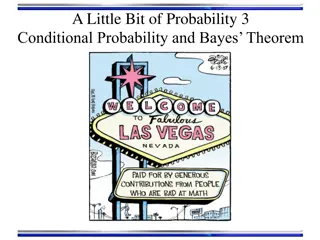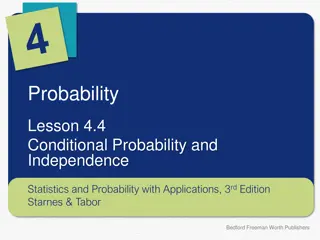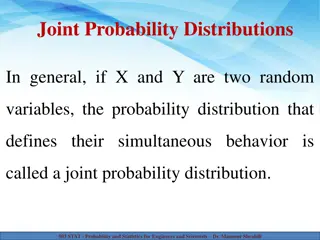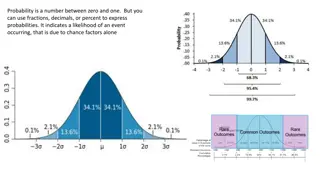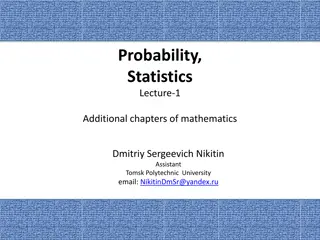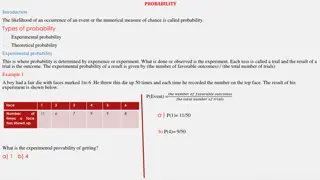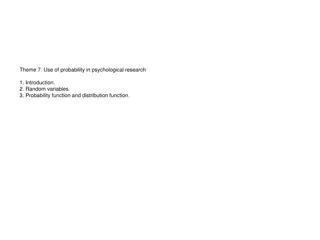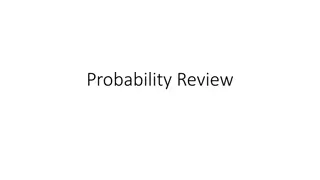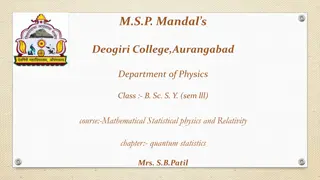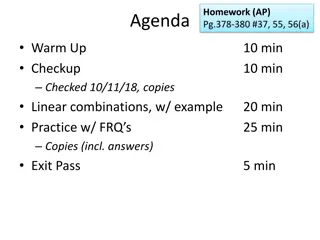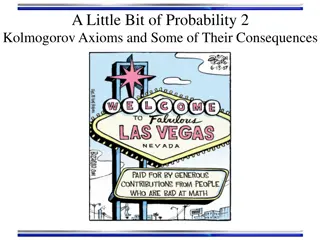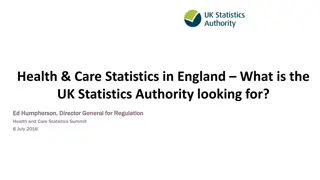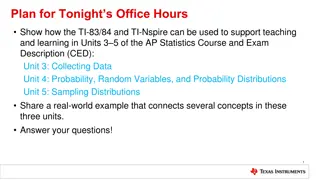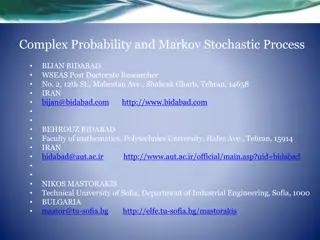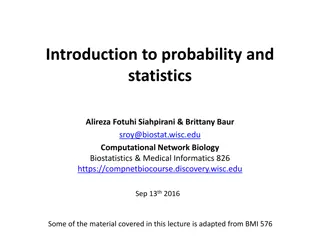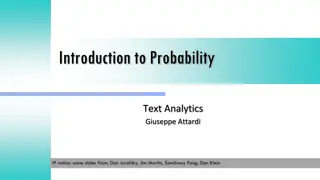Probability in Statistics
Learn about random experiments, sample space, and probabilities in statistics. Discover the concept of subjective and objective probabilities, classical probability, and empirical probability. Explore events and how they are defined in the context of probability theory.
Download Presentation

Please find below an Image/Link to download the presentation.
The content on the website is provided AS IS for your information and personal use only. It may not be sold, licensed, or shared on other websites without obtaining consent from the author. Download presentation by click this link. If you encounter any issues during the download, it is possible that the publisher has removed the file from their server.
E N D
Presentation Transcript
Chapters 1. Introduction 2. Graphs 3. Descriptive statistics 4. Basic probability 5. Discrete distributions 6. Continuous distributions 7. Central limit theorem 8. Estimation 9. Hypothesis testing 10. Two-sample tests 13. Linear regression 14. Multivariate regression Chapter 4 Probability
Random Experiment A Random Experiment is an action or process that leads to one of several possible outcomes. Experiment Outcomes Flip a coin Heads, Tails Exam Marks Numbers: 0, 1, 2, ..., 100 Assembly Time t > 0 seconds Course Grades F, D, C, B, A, A+ 10/9/2024 Towson University - J. Jung 6.2
Sample Space A list of exhaustive and mutually exclusive outcomes is called a sample space, denoted by S. Exhaustive: ALL possible outcomes are included Mutually exclusive: no two outcomes can occur at the same time The outcomes are denoted by O1, O2, , Ok We can represent the sample space and its outcomes as: S = {O1, O2, , Ok} Example: coin flip sample space: S={heads, tail} 10/9/2024 Towson University - J. Jung 6.3
Probabilities Given a sample space S = {O1, O2, , Ok}, the probabilities assigned to the outcome is a value between zero and one, inclusive, describing the relative possibility (chance or likelihood) the outcome will occur Flip a coin: P(head) = P(tail) = 0.5 Probability of occurrence = X / T X = number of ways in which event occurs T = total number of possible outcomes 10/9/2024 Towson University - J. Jung 6.4
Probabilities The sum of the probabilities of all the outcomes equals 1 e.g. P(head) + P(tail) = 1 10/9/2024 Towson University - J. Jung 5
Two Types of Probabilities 1. Subjective probability: relies on opinion and belief. 2. Objective probability: relies on theory or observation. (a) Classical probability: depends on theory or math, assuming that outcomes are equally likely, mutually exclusive, and collectively exhaustive. (b) Empirical (relative frequency)probability: depends on observations, experience, or DATA. 10/9/2024 Towson University - J. Jung 6.6
Events An Event is a collection of possible outcomes Sample space of rolling two dice: S={ (1,1), (1,2), (1,3), (1,4), (1,5), (1,6), (2,1), (2,2), (2,3), (2,4), (2,5), (2,6), (3,1), (3,2), (3,3), (3,4), (3,5), (3,6), (4,1), (4,2), (4,3), (4,4), (4,5), (4,6), (5,1), (5,2), (5,3), (5,4), (5,5), (5,6), (6,1), (6,2), (6,3), (6,4), (6,5), (6,6)} Examples of events could be: Event A: first toss equals 1 Event B: second toss equals 5 Event C: the two tosses sum to 7 10/9/2024 Towson University - J. Jung 7
Joint, Marginal, Conditional Probability We study methods to determine probabilities of events that result from combining other events in various ways. There are several types of combinations and relationships between events: 1. Complement event 2. Intersection of events 3. Union of events 4. Mutually exclusive events 5. Dependent and independent events 10/9/2024 Towson University - J. Jung 8
Complement of an Event The complement of event A is defined to be the event consisting of all sample points that are not in A . Complement of A is denoted by Ac The Venn diagram below illustrates the concept of a complement. A Ac P(A) + P(Ac ) = 1 10/9/2024 Towson University - J. Jung 9
Complement of an Event For example, the rectangle stores all the possible tosses of 2 dice {(1,1), (1,2), (6,6)} Let A = tosses totaling 7: A = {(1,6), (2, 5), (3,4), (4,3), (5,2), (6,1)} P(Total = 7) + P(Total not equal to 7) = 1 A Ac 10/9/2024 Towson University - J. Jung 6.10
Intersection of Two Events The intersection of events A and B is the set of all sample points that are in both A and B. The intersection is denoted: A and B The joint probability of A and B is the probability of the intersection of A and B, i.e. P(A and B) A B 10/9/2024 Towson University - J. Jung 6.11
Intersection of Two Events For example, let A = tosses where first toss is 1 {(1,1), (1,2), (1,3), (1,4), (1,5), (1,6)} and B = tosses where the second toss is 5 {(1,5), (2,5), (3,5), (4,5), (5,5), (6,5)} The intersection is {(1,5)} The joint probability of A and B is the probability of the intersection of A and B, i.e. P(A and B) = 1/36 A B 10/9/2024 Towson University - J. Jung 6.12
Union of Two Events The union of two events A and B, is the event containing all sample points that are in A or B or both: Union of A and B is denoted: A or B A B 10/9/2024 Towson University - J. Jung 6.13
Union of Two Events For example, let A = tosses where first toss is 1 {(1,1), (1,2), (1,3), (1,4), (1,5), (1,6)} and B is the tosses that the second toss is 5 {(1,5), (2,5), (3,5), (4,5), (5,5), (6,5)} Union of A and B is {(1,1), (1,2), (1,3), (1,4), (1,5), (1,6)} (2,5), (3,5), (4,5), (5,5), (6,5)} B A 10/9/2024 Towson University - J. Jung 6.14
Mutually Exclusive Events When two events are mutually exclusive (that is the two events cannot occur together), their joint probability is 0, hence: A B Mutually exclusive; no points in common For example A = tosses totaling 7 and B = tosses totaling 11 10/9/2024 Towson University - J. Jung 6.15
Basic Relationships of Probability Complement of Event Union of Events A B A Ac Intersection of Events Mutually Exclusive Events A B A B 10/9/2024 Towson University - J. Jung 6.16
Contingency Table A cross classification of two categorized variables. Why are some mutual fund managers more successful than others? One possible factor is whether the manager earned an MBA. The following table compares mutual fund performance against whether the fund manager earned an MBA: Succeed MBA .11 Fail Total .29 .40 Not MBA .06 .54 .60 Total .17 .83 1.00 Succeed: means manager outperformed the market Fail: manager did NOT outperform the market E.g. This is the probability that a mutual fund outperforms AND the manager was in a MBA program; it s a joint probability. 10/9/2024 Towson University - J. Jung 6.17
Marginal Probabilities Marginal probabilities are computed by adding across rows and down columns; that is they are calculated in the margins of the table: P(Not MBA) = .06 + .54 what s the probability a fund manager isn t from a MBA? Succeed (B1) .11 Not Succeed (B2) .29 P(Ai) .40 MBA (A1) Not MBA(A2) P(Bj) .06 .54 .60 .17 .83 1.00 P(Succeed) = .11 + .06 BOTH margins must add to 1 (useful error check) what s the probability a fund outperforms the market? 10/9/2024 Towson University - J. Jung 6.18
Conditional Probability Conditional probability is used to determine how two events are related; that is, we can determine the probability of one event given the occurrence of another related event. Conditional probabilities are written as P(A | B) and read as the probability of A givenB and is calculated as: 10/9/2024 Towson University - J. Jung 6.19
Conditional Probability Again, the probability of an event given that another event has occurred is called a conditional probability Note how A given B and B given A are related 10/9/2024 Towson University - J. Jung 6.20
Conditional Probability Example 6.2 What s the probability that a fund will outperform the market given that the manager graduated from a top-20 MBA program? Recall: A1 = Fund manager graduated from a top-20 MBA program A2 = Fund manager did not graduate from a top-20 MBA program B1 = Fund outperforms the market B2 = Fund does not outperform the market Thus, we want to know what is P(B1 | A1)? 10/9/2024 Towson University - J. Jung 21
Conditional Probability What s the probability that a fund succeed given that the manager graduated from an MBA program? B1 .11 B2 .29 P(Ai) .40 A1 A2 .06 .54 .60 .17 .83 1.00 P(Bj) Thus, there is a 27.5% chance that that a fund will succeed given that the manager graduated from a MBA program. 10/9/2024 Towson University - J. Jung 6.22
Independence Event A and B are independent, if the probability of one event is not affected by the occurrence of the other event. That is, if P(A|B) = P(A) or For example, we saw that P(B1 | A1) = 0.275 P(B|A) = P(B) The marginal probability for B1 is: P(B1) = 0.17 Since P(B1|A1) P(B1), B1 and A1 are not independent events. Stated another way, they are dependent. That is, the probability of one event (B1) is affected by the occurrence of the other event (A1). 10/9/2024 Towson University - J. Jung 6.23
Union We stated earlier that the union of two events is denoted as: A or B. We can use this concept to answer questions like: Determine the probability that a fund outperforms the market or the manager graduated from a top-20 MBA program. 10/9/2024 Towson University - J. Jung 24
Union Determine the probability that a fund outperforms (B1) or the manager graduated from a top-20 MBA program (A1). A1 or B1 occurs whenever: A1 and B1 occurs, A1 and B2 occurs, or A2 and B1occurs B1 .11 B2 .29 P(Ai) .40 A1 A2 .06 .54 .60 P(Bj) .17 .83 1.00 P(A1 or B1) = .11 + .06 + .29 = .46 10/9/2024 Towson University - J. Jung 25
Probability Rules and Trees We introduce three rules that enable us to calculate the probability of more complex events from the probability of simpler events 1. The Complement Rule 2. The Multiplication Rule 3. The Addition Rule 10/9/2024 Towson University - J. Jung 6.26
1 Complement Rule The complement of an event A is the event that occurs when A does not occur. The complement rule gives us the probability of an event NOT occurring. That is: A Ac P(AC) = 1 P(A) For example, in the simple roll of a die, the probability of the number 1 being rolled is 1/6. The probability that some number other than 1 will be rolled is 1 1/6 = 5/6. 10/9/2024 Towson University - J. Jung 6.27
2 Multiplication Rule The multiplication rule is used to calculate the joint probability of two events. It is based on the formula for conditional probability defined earlier: If we multiply both sides of the equation by P(B) we have: P(A and B) = P(A | B) P(B) Likewise, P(A and B) = P(B | A) P(A) If A and B are independent events, then P(A and B) = P(A) P(B) 10/9/2024 Towson University - J. Jung 6.28
Example A graduate statistics course has seven male and three female students. The professor wants to select two students at random to help her conduct a research project. What is the probability that the two students chosen are female? Let A represent the event that the first student is female P(A) = 3/10 = .30 What about the second student? 10/9/2024 Towson University - J. Jung 6.29
Example Let B represent the event that the second student is female P(B | A) = 2/9 = .22 That is, the probability of choosing a female student given that the first student chosen is 2 (females) / 9 (remaining students) = 2/9 10/9/2024 Towson University - J. Jung 6.30
Example A graduate statistics course has seven male and three female students. The professor wants to select two students at random to help her conduct a research project. What is the probability that the two students chosen are female? Thus, we want to answer the question: what is P(A and B) ? P(A and B) = P(A) P(B|A) = (3/10)(2/9) = 6/90 = .067 There is a 6.7% chance that the professor will choose two female students from her grad class of 10. 10/9/2024 Towson University - J. Jung 6.31
Example The professor in Example 6.5 is unavailable. Her replacement will teach two classes. His style is to select one student at random and pick on him or her in the class. What is the probability that the two students chosen are female? Let A represent the event that the first student picked at random is female P(A) = 3/10 = .30 What about the second class? 10/9/2024 Towson University - J. Jung 6.32
Example Let B represent the event that the second student is female. Because the same student in the first class can be picked again for the second class P(B | A) = P(B) = 3/10 = .30 10/9/2024 Towson University - J. Jung 6.33
Example What is the probability that the two students chosen are female? Thus, we want to answer the question: what is P(A and B) ? P(A and B) = P(A) P(B) = (3/10)(3/10) = 9/100 = .09 There is a 9% chance that the replacement professor will choose two female students from his two classes. 10/9/2024 Towson University - J. Jung 6.34
3 Addition Rule The probability of event A or B or both A and B occurring; i.e. the union of A and B. P(A or B) = P(A) + P(B) P(A and B) + A B A B = If A and B are mutually exclusive, then this term goes to zero P(A or B) = P(A) + P(B) P(A and B) 10/9/2024 Towson University - J. Jung 6.35
Example 6.7 In a large city, two newspapers are published, the Sun and the Post. The circulation departments report that 22% of the city s households have a subscription to the Sun and 35% subscribe to the Post. A survey reveals that 6% of all households subscribe to both newspapers. What proportion of the city s households subscribe to either newspaper? P(Sun or Post) = P(Sun) + P(Post) P(Sun and Post) = .22 + .35 .06 = .51 There is a 51% probability that a randomly selected household subscribes to one or the other or both papers 10/9/2024 Towson University - J. Jung 36
Optional 10/9/2024 Towson University - J. Jung 37
Probability Tree An effective and simpler method of applying the probability rules is the probability tree, wherein the events in an experiment are represented by lines. The resulting figure resembles a tree, hence the name. 10/9/2024 Towson University - J. Jung 38
Probability Trees A probability tree is a simple and effective method of applying the probability rules by representing events in an experiment by lines. The resulting figure resembles a tree. Recall Example 6.5. Joint probabilities First selection Second selection P(FF)=(3/10)(2/9) P(FM)=(3/10)(7/9) P(MF)=(7/10)(3/9) P(MM)=(7/10)(6/9) 10/9/2024 Towson University - J. Jung 6.39
Probability Trees The probabilities associated with any set of branches from one node must add up to 1.00 First selection Second selection 2/9 + 7/9 = 9/9 = 1 3/9 + 6/9 = 9/9 = 1 Handy way to check your work ! 3/10 + 7/10 = 10/10 = 1 10/9/2024 Towson University - J. Jung 6.40
Probability Trees Note: there is no requirement that the branches splits be binary, nor that the tree only goes two levels deep, or that there be the same number of splits at each sub node 10/9/2024 Towson University - J. Jung 6.41
Bayes Law Bayes Law is named for Thomas Bayes, an eighteenth century mathematician. In its most basic form, if we know P(B | A), we can apply Bayes Law to determine P(A | B) P(B|A) P(A|B) for example 10/9/2024 Towson University - J. Jung 42
Bayes Law 1 ( ) ( ) P A and B P A and B ( ) ( ) = = | , | P A B and P B A ( ) B Multiplica ( ) A P P have So that given the tion = Rule, we : ( ) ( ) ( ) P one ( ) ( ) P = | | P We A and can B P B either A A P the A B B express of conditiona probabilit l ies in terms of the other one : ( ) ( ) ( ) B ( ) ( ) ( ) A | | P B A P A P A B P B ( ) ( ) = = | , | P A B or P B A P P 10/9/2024 Towson University - J. Jung 43
Bayes Law 2 ies probabilit + The marginal = can be expressed as : ( ( ) ( ) ( P ) ) ( ) ( ) Combining ( ( ) ( ) ) ( ) expression the C C P B | | , P B A P A P B A P A = + C C | | . P A P A B P B P A B B for conditiona and l marginal P probabilit P A ies : ( A ) ( ) ( ) ( ) ( A P | + B A ( ) = | , P A B or ) ( P ) ( ) ( ) P C C | | P B A P P B A A ( B | + A B P B ( ) = | ). P B A ) ( P ( ) ( ) P C C | | P A B B B 10/9/2024 Towson University - J. Jung 44
Bayes Law 3 ( ) ( ) ) ( ) ( B P A P + | P B A P A | ( ) = | P A B ) ( P ) ( C C | P B A A A P(B) = P(B|A)P(A) + First selection Second selection P(B|Ac)P(Ac) P(A and B) P(A and Bc) P(Bc) = P(Bc|A)P(A) P(Ac and B) + P(Bc|Ac)P(Ac) P(Ac and Bc) 10/9/2024 Towson University - J. Jung 6.45
Bayes Law 3 B Bc Total A P(A and B) P(A and Bc) P(A) Ac P(Ac and B) P(Ac and Bc) P(Ac) Total P(B) P(Bc) 1.00 10/9/2024 Towson University - J. Jung 6.46
Example 6.9 Pay $500 for MBA prep?? The Graduate Management Admission Test (GMAT) is a requirement for all applicants of MBA programs. There are a variety of preparatory courses designed to help improve GMAT scores, which range from 200 to 800. Suppose that a survey of MBA students reveals that among GMAT scorers above 650, 52% took a preparatory course, whereas among GMAT scorers of less than 650 only 23% took a preparatory course. An applicant to an MBA program has determined that he needs a score of more than 650 to get into a certain MBA program, but he feels that his probability of getting that high a score is quite low--10%. He is considering taking a preparatory course that cost $500. He is willing to do so only if his probability of achieving 650 or more doubles. What should he do? 10/9/2024 Towson University - J. Jung 6.47
Example 6.9 Convert to Statistical Notation Let A = GMAT score of 650 or more, hence AC = GMAT score less than 650 Our student has determined the probability of getting greater than 650 (without any prep course) as 10%, that is: P(A) = 0.10 It follows that P(AC) = 1 0.10 = 0.90 10/9/2024 Towson University - J. Jung 6.48
Example 6.9 Convert to Statistical Notation Let B represent the event take the prep course and thus, BC is do not take the prep course From our survey information, we re told that among GMAT scorers above 650, 52% took a preparatory course, that is: P(B | A) = .52 (Probability of finding a student who took the prep course given thatthey scored above 650 ) But our student wants to know P(A | B), that is, what is the probability of getting more than 650 given that a prep course is taken? If this probability is > 20%, he will spend $500 on the prep course. 10/9/2024 Towson University - J. Jung 6.49
Example 6.9 Convert to Statistical Notation Among GMAT scorers of less than 650 only 23% took a preparatory course. That is: P(B |AC ) = .23 (Probability of finding a student who took the prep course given that he or she scored less than 650 ) 10/9/2024 Towson University - J. Jung 6.50
